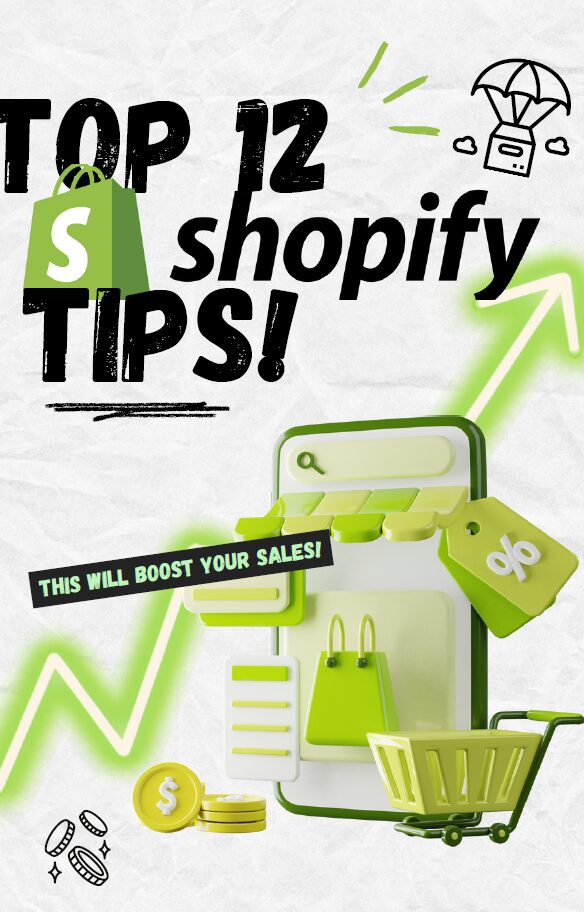Building a Shopify store is easy, but building one that actually sells is where most people struggle. If you’re tired of low sales or no traction, these 12 Shopify tips will help you finally see real results. We’ve also put together a free guide that discusses more, so you can avoid common mistakes and start earning consistently. Let’s get into it.
Before we start, if you haven’t signed up or you’re still considering getting Shopify, let us save you some time. Shopify is the go-to platform for e-commerce businesses for a reason. It’s beginner-friendly, secure, and built to scale as your store grows. You get everything you need to launch and sell from day one; no coding and no expensive developer is needed. If you’re ready to start selling, this is the platform I recommend.

Starting from $17/month
Sign up for a free trial and enjoy 3 months of Shopify for $1/month on select plans
Key Features
AI-powered product recommendations and marketing
Advanced fulfillment and inventory management
Seamless omnichannel selling
Why We Recommend It
Storage and Bandwidth:
Unlimited storage allows you to upload as many products and images as needed
Unlimited bandwidth means your site can handle many visitors and lots of activity without slowing down
Extras and Inclusions:
Secure, integrated payment gateway, with transaction fees waived if you use Shopify Payments
Access to an extensive app store to add features and functionality
Built-in tools for SEO, marketing, and analytics
Pros & Cons
- Comprehensive store management tools
- Wide range of themes and apps
- Excellent 24/7 customer support
- It can get expensive with additional apps and transaction fees
- Limited SEO capabilities compared to other platforms
Tip 1: Start with a Clean, Fast Theme
Your store is your storefront, and if it’s messy or slow, people won’t stick around. Choose a mobile-friendly, fast-loading theme like Dawn or Debutify. Avoid clutter. Keep your fonts simple and easy to read.
Remember: most customers shop on their phones now. If your store loads slowly or looks clunky on mobile, they’re gone in seconds.
Tip 2: Optimize Product Pages
Think of your product pages like your sales pitch. They need to:
- Use high-quality photos: no pixelated images or bad lighting. Show products from different angles and in real-life situations.
- Add compelling descriptions: focus on benefits, not just specs. How will this product make life easier or better?
- Include trust signals: such as reviews, star ratings, or badges. They tell visitors that other people have bought and liked this product.
Don’t just list what it is, sell what it does.
Tip 3: Simplify Your Checkout
Every extra click is a chance to lose a customer.
Shopify’s built-in checkout is already optimized, but you can still:
- Remove any fields you don’t really need
- Offer guest checkout (no forced account creation)
- Show progress bars so people know how close they are to “done”
The smoother the checkout, the better your conversion rates.
Tip 4: Use Scarcity and Urgency
People buy faster when they feel they might miss out.
Use real scarcity tools like:
- “Only 3 left in stock” notices (if true!)
- Countdown timers for special offers
- Limited-time discount codes
But don’t fake it, shoppers can tell if you’re lying, and it’ll hurt your credibility long term.
Tip 5: Add Social Proof
No one wants to be the first to buy something. Show them what others already have.
- Display customer reviews prominently
- Include user-generated content (like customer photos)
- Highlight any social media shoutouts or mentions
It makes your store feel like a real community, not a faceless brand.
Tip 6: Make It Easy to Contact You
People trust real people. Instead of concealing yourself behind your email form, step forward and connect with your audience in a real and authentic way. You can create:
- A clear contact page with your business email
- Live chat or a chatbot (even if you start with automated replies)
- An FAQ page to handle common questions up front
If customers know they can reach you, they’re more likely to buy.
Tip 7: Offer Free Shipping (If You Can)
Free shipping is a proven conversion booster.
If you can’t cover it outright, bake it into your product pricing. Example: Instead of $40 + $5 shipping, charge $45 with “free shipping.” It feels like a better deal to customers, even if the math is the same.
Tip 8: Upsell and Cross-Sell
Don’t let valuable opportunities slip away! Leverage powerful tools like Bold Upsell or ReConvert to maximize your earnings. These dynamic platforms can seamlessly enhance your sales strategy, ensuring you capture every potential dollar. Embrace the possibilities they offer to boost your bottom line.
- Suggest complementary products at checkout (like phone cases for phone orders)
- Offer volume discounts (buy 2, save 10%)
- Show bundles that make sense together
Small tweaks here can add hundreds to your monthly revenue.
Tip 9: Leverage Email Marketing
Most people don’t buy the first time they visit. That’s normal.
Use a simple pop-up to capture emails, like offering 10% off their first purchase. Then set up:
- Welcome emails to build trust
- Abandoned cart reminders to recover missed sales
- Regular updates to keep your brand top-of-mind
Tools like Shopify Email or Klaviyo make this easy.
Tip 10: Run Retargeting Ads
Ever notice how that pair of shoes you looked at follows you around the internet?
That’s retargeting. Use it to:
- Remind people about products they viewed
- Offer a special discount to bring them back
- Finish the sale without guessing who’s interested
It’s cheaper than cold ads because you’re only targeting warm leads.
Tip 11: Add SEO Basics
SEO sounds complicated, but it’s not. Start simple:
- Use keywords in your product titles and descriptions
- Add alt text to your images for Google
- Write clear meta descriptions that show up in search results
SEO brings free, consistent traffic that compounds over time.
Read our blog ‘SEO in 2025: Adapting to The Latest Search Engine Algorithms’ and learn how to stay ahead with SEO in 2025 by adapting to AI changes, improving user experience, and using tools like Semrush to boost visibility and traffic.
Tip 12: Keep Testing and Improving
Your first version is just that, a starting point.
Use tools like Google Analytics or Shopify’s built-in reports to:
- See what products or pages perform best
- Identify drop-off points in your funnel
- Test small changes (like button colors or headlines) to see what converts better
Little tweaks = big impact over time.

Top 12 Shopify Tips to Boost Your Sales
Download this freebie to help you avoid building a failing business. I’ve compiled the top 12 tips for launching a successful Shopify store.
To download this freebie, please enter your email address below.
Download this freebie to help you avoid building a failing business. We’ve compiled the top 12 tips for launching a successful Shopify store.



